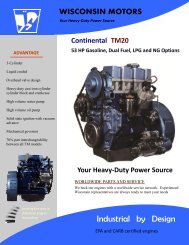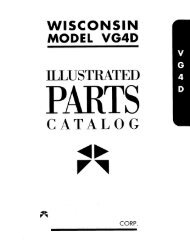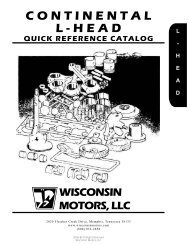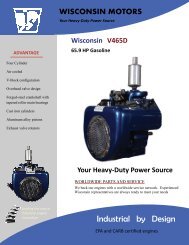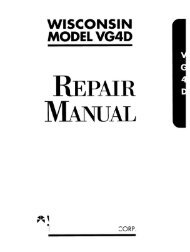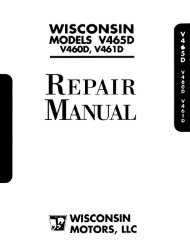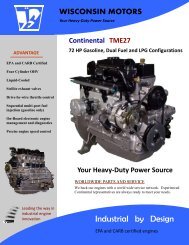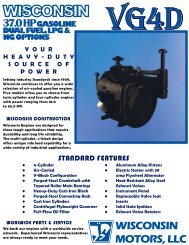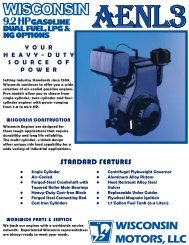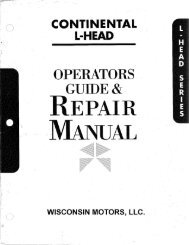REPAIR MANUAL - Wisconsin Motors
REPAIR MANUAL - Wisconsin Motors
REPAIR MANUAL - Wisconsin Motors
- No tags were found...
Create successful ePaper yourself
Turn your PDF publications into a flip-book with our unique Google optimized e-Paper software.
Section 4 - Coo ing System<br />
The function of the cooling system is to prevent<br />
the temperatures in the combustion chamber from<br />
damaging the engine and at the same time keep the<br />
operating temperatures within safe limits.<br />
Maintaining the cooling system efficiency is imo<br />
portant, as engine temperatures must be brought up<br />
to and maintained within satisfactory range for efficient<br />
operation; however, this system must be kept<br />
from overheating, in order to prevent damage to<br />
valves, pistons and bearings.<br />
CAUTION: OVERHEATED ENGINE never pour cold<br />
water or cold anti-freeze into the radiator of an overheated<br />
engine. Allow the engine to cool and avoid the<br />
danger of cracking the cylinder head or block. Keep<br />
engine running while adding coolant.<br />
period. When desired temperature is reached, the<br />
thermostat valve opens allowing all the coolant to<br />
circulate through both the engine and radiator, while<br />
shutting off the by-pass system.<br />
IMPORTANT: Present thermostats begin to open at<br />
81°C (180°F) and are fully open at 94°C (202°F).<br />
Operation of engines<br />
this temperature range is not<br />
harmful. However, temperature gauges are not always<br />
accurate and may sometimes indicate higher<br />
than actual temperature. This can lead operators to<br />
believe engines are overheating when they are actually<br />
operating normally.<br />
COOLING SYSTEM<br />
All Continental industrial diesel engines have the<br />
coolant force-circulated by a water pump and use a<br />
thermostat and by-pass system to control the temperature<br />
range.<br />
The coolant from the pump enters the front of the<br />
block, passing along and between the cylinder bores<br />
and is metered by the head gasket into and across<br />
the cylinder head to cool the pre-combustion chambers,<br />
valve seats and guides.<br />
Upon leaving the cylinder head, the coolant enters<br />
the thermostat housing, in which is mounted the<br />
positive shut-off thermostat, which controls the opening<br />
to the radiator or heat exchanger. Upon being<br />
discharged from the thermostat housing, the coolant<br />
enters the radiator or heat exchanger, depending<br />
upon the application, where it is cooled before reentry<br />
into the engine.<br />
Continental industrial diesel engines operate<br />
most efficiently with coolant temperatures of 81°-<br />
93°C (180°-200°F) and a thermostat and bypass<br />
system is used to control these temperatures.<br />
The thermostat valve remains closed and only<br />
allows the coolanto circulate within the engine itself<br />
until normal operating temperatures are reached.<br />
This provides for both rapid and even temperature<br />
increase of all engine parts during the warm-up<br />
;ectional View showing Coolant Passages in Head and Block<br />
EXPANSION OF WATER<br />
Water has always been the most commonly used<br />
coolant for internal combustion engines because it<br />
has excellent heat transfer ability and is readily obtained<br />
everywhere. Like all liquids it expands when<br />
heated, the rate of expansion being 1/32 liter per liter<br />
(1/4 pint per gallon) when the temperature is raised<br />
from 4 ° to 81°C (40 ° to 180°F).<br />
For example: If a 4 gallon cooling system is filled<br />
completely full ofwater at4°C (40°F), 1 pintwill be lost<br />
through the radiator overflow pipe by the time the<br />
water temperature reaches 81°C (180°F).<br />
WATER FILTERS<br />
In some areas, the chemical content of the water<br />
is such that even the best of rust inhibitors will not<br />
protect the cooling system from the formation of rust<br />
and scale.<br />
There are instances where this corrosive element<br />
has eaten holes through cast iron parts such as<br />
water pump impellers and bodies. This condi-<br />
15



